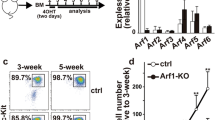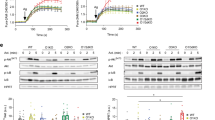Abstract
Dos/Gab family scaffolding adapters (Dos, Gab1, Gab2) bind several signal relay molecules, including the protein-tyrosine phosphatase Shp-2 and phosphatidylinositol-3-OH kinase (PI(3)K); they are also implicated in growth factor, cytokine and antigen receptor signal transduction1. Mice lacking Gab1 die during embryogenesis and show defective responses to several stimuli2,3. Here we report that Gab2-/- mice are viable and generally healthy; however, the response (for example, degranulation and cytokine gene expression) of Gab2-/- mast cells to stimulation of the high affinity immunoglobulin-ε (IgE) receptor FcεRI is defective. Accordingly, allergic reactions such as passive cutaneous and systemic anaphylaxis are markedly impaired in Gab2-/- mice. Biochemical analyses reveal that signalling pathways dependent on PI(3)K, a critical component of FcεRI signalling, are defective in Gab2-/- mast cells. Our data identify Gab2 as the principal activator of PI(3)K in response to FcεRI activation, thereby providing genetic evidence that Dos/Gab family scaffolds regulate the PI(3)K pathway in vivo. Gab2 and/or its associated signalling molecules may be new targets for developing drugs to treat allergy.
This is a preview of subscription content, access via your institution
Access options
Subscribe to this journal
Receive 51 print issues and online access
$199.00 per year
only $3.90 per issue
Buy this article
- Purchase on Springer Link
- Instant access to full article PDF
Prices may be subject to local taxes which are calculated during checkout




Similar content being viewed by others
References
Hibi, M. & Hirano, T. Gab-family adapter molecules in signal transduction of cytokine and growth factor receptors, and T and B cell antigen receptors. Leuk. Lymphoma 37, 299–307 (2000).
Itoh, M. et al. Role of Gab1 in heart, placenta, and skin development and growth factor- and cytokine-induced extracellular signal-regulated kinase mitogen-activated protein kinase activation. Mol. Cell. Biol. 20, 3695–3704 (2000).
Sachs, M. et al. Essential role of Gab1 for signaling by the c-Met receptor in vivo. J. Cell Biol. 150, 1375–1384 (2000).
Saitoh, S. et al. LAT is essential for Fc(ε)RI-mediated mast cell activation. Immunity 12, 525–535 (2000).
Turner, H. & Kinet, J. P. Signalling through the high-affinity IgE receptor FcεRI. Nature 402, B24–30 (1999).
Scharenberg, A. M. et al. Phosphatidylinositol-3,4,5-trisphosphate (PtdIns-3,4,5-P3)/Tec kinase-dependent calcium signaling pathway: a target for SHIP-mediated inhibitory signals. EMBO J. 17, 1961–1972 (1998).
Franke, T. F., Kaplan, D. R., Cantley, L. C. & Toker, A. Direct regulation of the Akt proto-oncogene product by phosphatidylinositol-3,4-biphosphate. Science 275, 665–668 (1997).
Falasca, M. et al. Activation of phospholipase Cγ by PI 3-kinase-induced PH domain-mediated membrane targeting. EMBO J. 17, 414–422 (1998).
Bae, Y. S. et al. Activation of phospholipase C-γ by phosphatidylinositol 3,4,5-trisphosphate. J. Biol. Chem. 273, 4465–4469 (1998).
Nakanishi, S., Yano, H. & Matsuda, Y. Novel functions of phosphatidylinositol 3-kinase in terminally differentiated cells. Cell Signal 7, 545–557 (1995).
Barker, S. A. et al. Wortmannin blocks lipid and protein kinase activities associated with PI 3-kinase and inhibits a subset of responses induced by FcεR1 cross-linking. Mol. Biol. Cell 6, 1145–1158 (1995).
Barker, S. A., Lujan, D. & Wilson, B. S. Multiple roles for PI 3-kinase in the regulation of PLCγ activity and Ca2+ mobilization in antigen-stimulated mast cells. J. Leukoc. Biol. 65, 321–329 (1999).
Kawakami, Y., Hartman, S. E., Holland, P. M., Cooper, J. A. & Kawakami, T. Multiple signalling pathways for the activation of JNK in mast cells: involvement of Bruton's tyrosine kinase, protein kinase C, and JNK kinases, SEK1 and MKK7. J. Immunol. 161, 1795–1802 (1998).
Ishizuka, T. et al. Mitogen-activated protein kinase activation through Fcε receptor I and stem cell factor receptor is differentially regulated by phosphatidylinositol 3-kinase and calcineurin in mouse bone marrow-derived mast cells. J. Immunol. 162, 2087–2094 (1999).
Raabe, T. et al. DOS, a novel pleckstrin homology domain-containing protein required for signal transduction between sevenless and Ras1 in Drosophila. Cell 85, 911–920 (1996).
Gu, H., Pratt, J. C., Burakoff, S. J. & Neel, B. G. Cloning of p97/Gab2, the major SHP-2 binding protein in hematopoietic cells, reveals a novel pathway for cytokine-induced gene activation. Mol. Cell 2, 729–740 (1998).
Nishida, K. et al. Gab-family adapter proteins act downstream of cytokine and growth factor receptors and T- and B-cell antigen receptors. Blood 93, 1809–1816 (1999).
Gu, H. et al. New role for Shc in activation of the phosphatidylinositol 3-kinase/Akt pathway. Mol. Cell. Biol. 20, 7109–7120 (2000).
Pratt, J. C. et al. Cutting edge: gab2 mediates an inhibitory phosphatidylinositol 3′-kinase pathway in T cell antigen receptor signaling. J. Immunol. 165, 4158–4163 (2000).
Rameh, L. E. et al. Phosphoinositide 3-kinase regulates phospholipase Cγ-mediated calcium signaling. J. Biol. Chem. 273, 23750–23757 (1998).
Galli, S. J. Mast cells and basophils. Curr. Opin. Hematol. 7, 32–39 (2000).
Rameh, L. E. et al. A comparative analysis of the phosphoinositide binding specificity of pleckstrin homology domains. J. Biol. Chem. 272, 22059–22066 (1997).
Liu, Y. C. & Altman, A. Cbl: complex formation and functional implications. Cell Signal 10, 377–385 (1998).
Gommerman, J. L. et al. A role for CD21/CD35 and CD19 in responses to acute septic peritonitis: a potential mechanism for mast cell activation. J. Immunol. 165, 6915–6921 (2000).
Yang, F. C. et al. Rac2 stimulates Akt activation affecting BAD/Bcl-XL expression while mediating survival and actin function in primary mast cells. Immunity 12, 557–568 (2000).
Lu-Kuo, J. M., Fruman, D. A., Joyal, D. M., Cantley, L. C. & Katz, H. R. Impaired kit- but not FcεRI-initiated mast cell activation in the absence of phosphoinositide 3-kinase p85α gene products. J. Biol. Chem. 275, 6022–6029 (2000).
Dombrowicz, D. et al. Absence of FcεRI alpha chain results in upregulation of FcγRIII-dependent mast cell degranulation and anaphylaxis. Evidence of competition between FcεRI and FcγRIII for limiting amounts of FcR beta and gamma chains. J. Clin. Invest. 99, 915–925 (1997).
Schwaller, J. et al. Transformation of hematopoietic cell lines to growth-factor independence and induction of a fatal myelo- and lymphoproliferative disease in mice by retrovirally transduced TEL/JAK2 fusion genes. EMBO J. 17, 5321–5333 (1998).
Craddock, B. L., Orchiston, E. A., Hinton, H. J. & Welham, M. J. Dissociation of apoptosis from proliferation, protein kinase B activation, and BAD phosphorylation in interleukin-3-mediated phosphoinositide 3-kinase signaling. J. Biol. Chem. 274, 10633–10640 (1999).
Acknowledgements
We thank J. Lawitts for blastocyst injections; V. Petkova for help with Real Time PCR analysis; D. P. Liu for technical assistance; and. L. C. Cantley and C. Carpenter for comments. This work was supported by grants from the N.I.H. (B.G.N, J.-P.K. and B.L.). H.G. was supported by fellowships from the N.I.H. and the American Association for Cancer Research. J.C.P. was supported by grants from the Cancer League of Colorado and the Association for International Cancer Research.
Author information
Authors and Affiliations
Corresponding author
Supplementary information

Figure 1
(JPG 81.4 KB)
Targeted disruption of the murine Gab2 gene. a, Targeting strategy. A P1 clone containing exon 1 of murine Gab2 was purchased from Genome Systems. The 10.5 kb EcoRI DNA fragment harboring this exon was excised, subcloned, and restriction-mapped (Supp. Fig.1). A targeting vector was designed to replace the first exon with an SAbgal pgkneo cassette, using the Loxp-SAbgal pgkneo-loxp-DTA plasmid as the backbone (provided by Sheila Thomas, BIDMC, Boston). Further details are available from H.G. upon request. b, Southern blot of EcoRI-digested genomic DNA with the probe indicated as "-P". Gab2 targeting construct was electroporated into J1 ES cells (provided by Dr. Arlene Sharpe, Brigham and Women’s Hospital, Boston). Proper targeting was verified in 6 clones (out of 100 G418R clones) by Southern blot. ES clone 14 with an unrearranged Gab2 locus shows only the 9.4 kb endogenous band. ES clones (23, 31, 68) shown exhibit homologous recombination indicated by the additional 6.5 kb band. c, Gab2-/- mice are viable. Two independent targeted clones were injected into C57/Bl6 blastocysts. High percentage chimeras were bred to wild type C57/Bl6 mice or 129Sv mice to obtain Gab2+/-mice (Sv129 X C57/Bl6 or 129Sv, respectively). Gab2 -/- mice were generated interbreeding Gab2 +/- mice. PCR genotyping reveals Gab2+/+, Gab2+/- and Gab2-/- mice. The protocol for genotyping Gab2 mice is available from HG upon request. d, Gab2 protein is undetectable in tissues of Gab2-/- mice. Gab2 immunoprecipitates from lysates (1 mg) of brain (B), spleen (S), and testis (T) were immunoblotted with anti-Gab2 antibodies. Similar results were obtained with direct Gab2 immunoblots from liver, lung, heart and muscle tissues. Lysates from each of the same samples were immunoblotted with anti-Shp-2 antibodies to control for loading.
Rights and permissions
About this article
Cite this article
Gu, H., Saito, K., Klaman, L. et al. Essential role for Gab2 in the allergic response. Nature 412, 186–190 (2001). https://doi.org/10.1038/35084076
Received:
Accepted:
Issue Date:
DOI: https://doi.org/10.1038/35084076
This article is cited by
-
Mast cell deficiency prevents BCR::ABL1 induced splenomegaly and cytokine elevation in a CML mouse model
Leukemia (2023)
-
Gab2 deficiency prevents Flt3-ITD driven acute myeloid leukemia in vivo
Leukemia (2022)
-
Gab1 Overexpression Attenuates Susceptibility to Ventricular Arrhythmias in Pressure Overloaded Heart Failure Mouse Hearts
Cardiovascular Drugs and Therapy (2022)
-
Gab2 deficiency suppresses high-fat diet-induced obesity by reducing adipose tissue inflammation and increasing brown adipose function in mice
Cell Death & Disease (2021)
-
A phenotypic and genomics approach in a multi-ethnic cohort to subtype systemic lupus erythematosus
Nature Communications (2019)
Comments
By submitting a comment you agree to abide by our Terms and Community Guidelines. If you find something abusive or that does not comply with our terms or guidelines please flag it as inappropriate.



